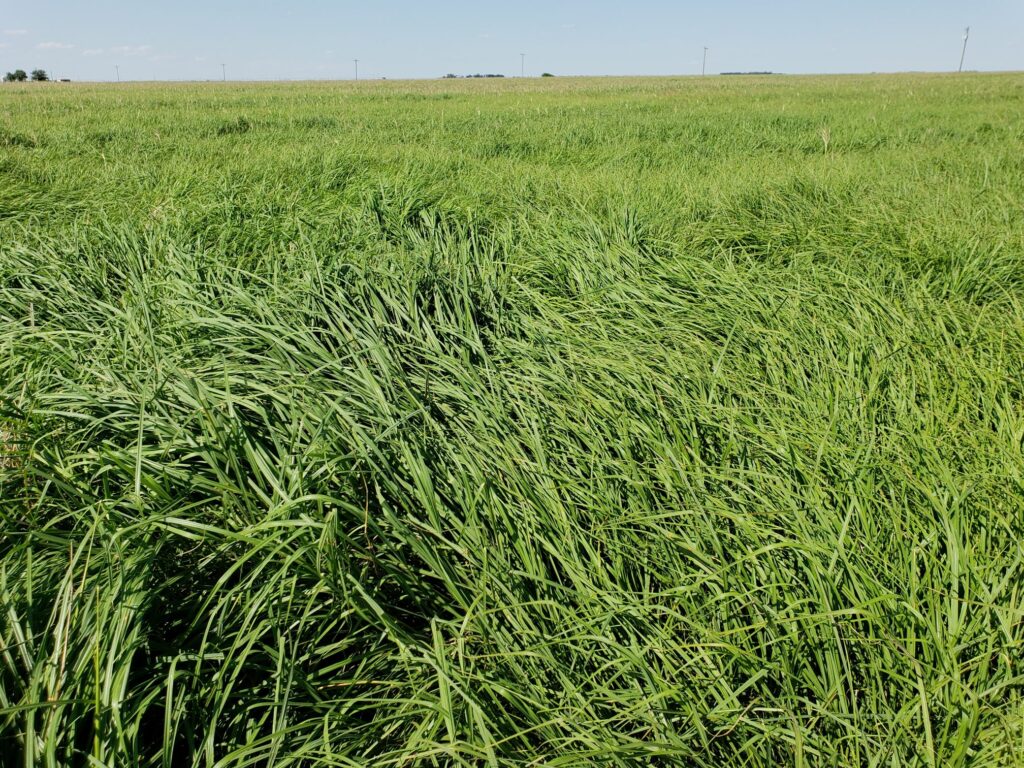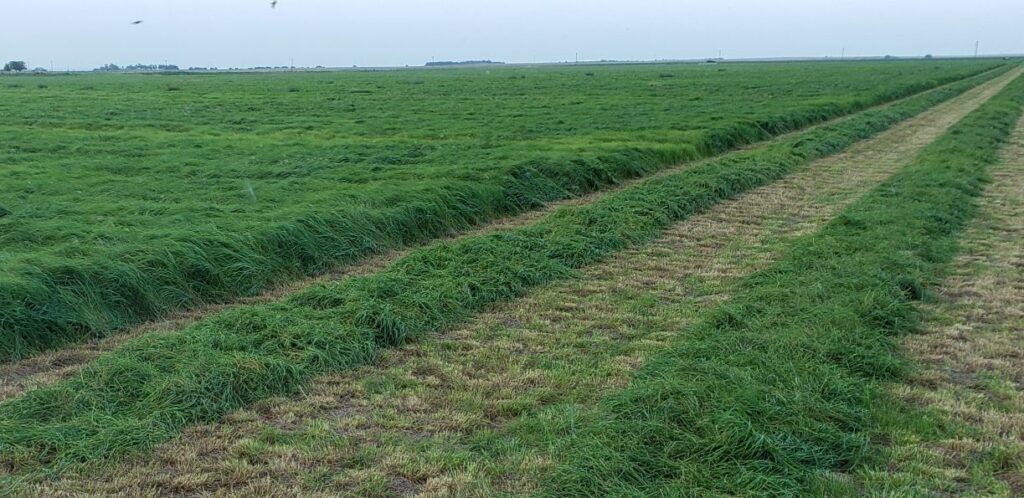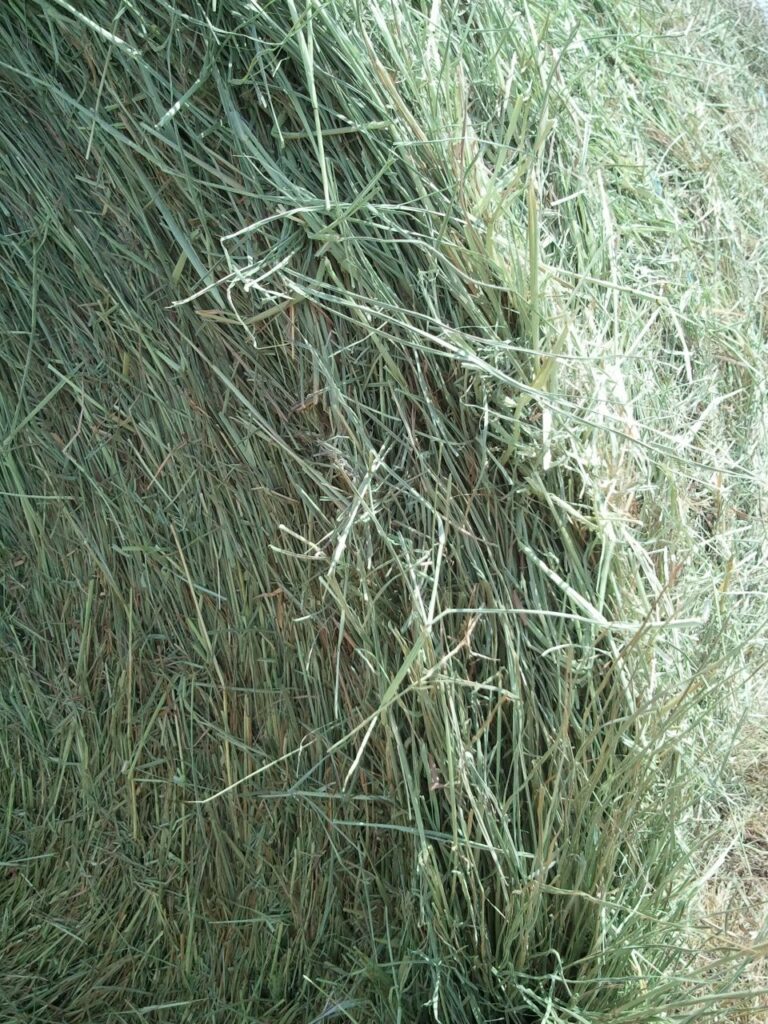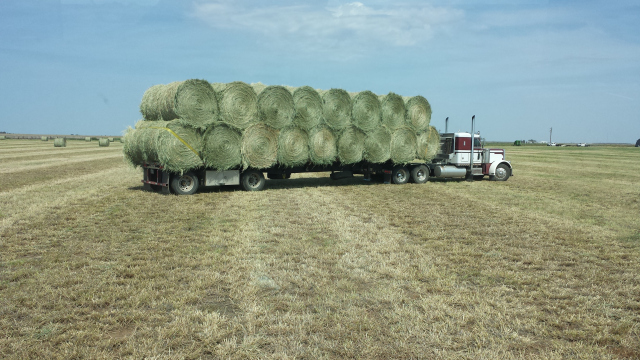B Dahl Bluestem
(Bothriochloa bladhii.)
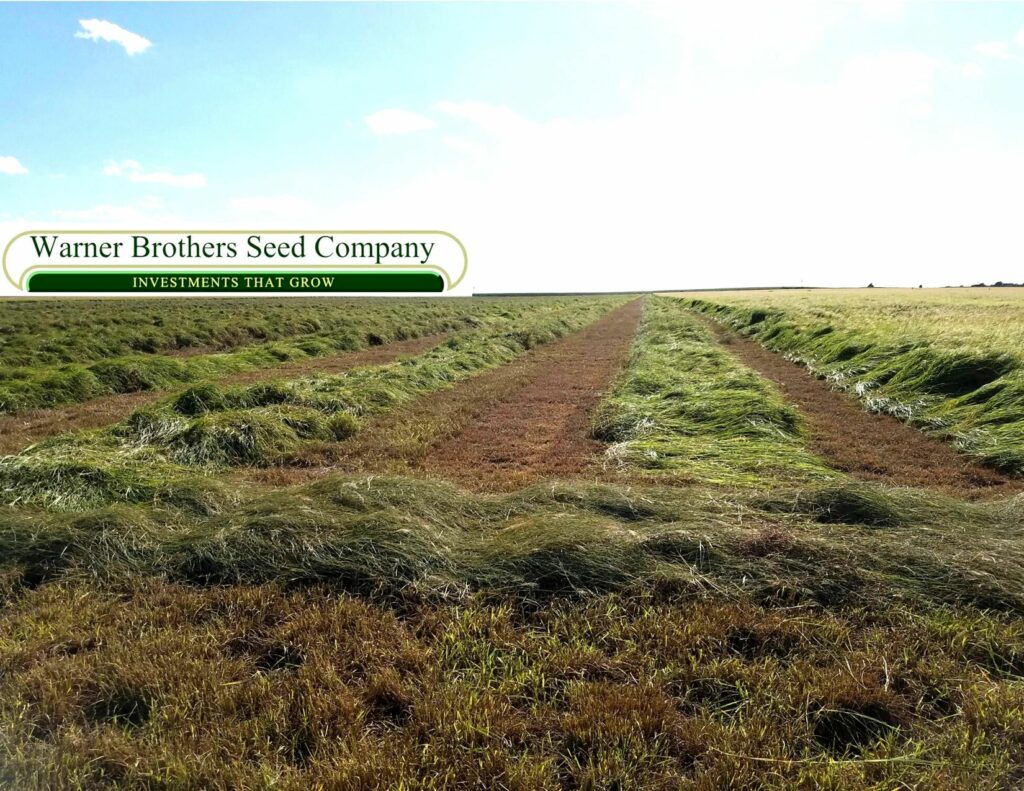
The newest Old World bluestem cultivar is ‘WW-B. Dahl.’ The correct species classification for “WW B. Dahl” Old World Bluestem is Bothriochloa bladhii.
Old World bluestems include several species of warm-season grasses that were introduced from Europe and Asia from 1920-1965. These grasses have been studied extensively in Oklahoma for the last 40 years.
Old World bluestems are warm-season bunchgrasses that possess good forage potential for the southern Great Plains. These grasses respond very well to fertilization, are drought and cold tolerant for the most part, withstand close grazing, and are palatable to cattle. Old World bluestems are not closely related to the native big and little bluestem grasses domestic to the USA.
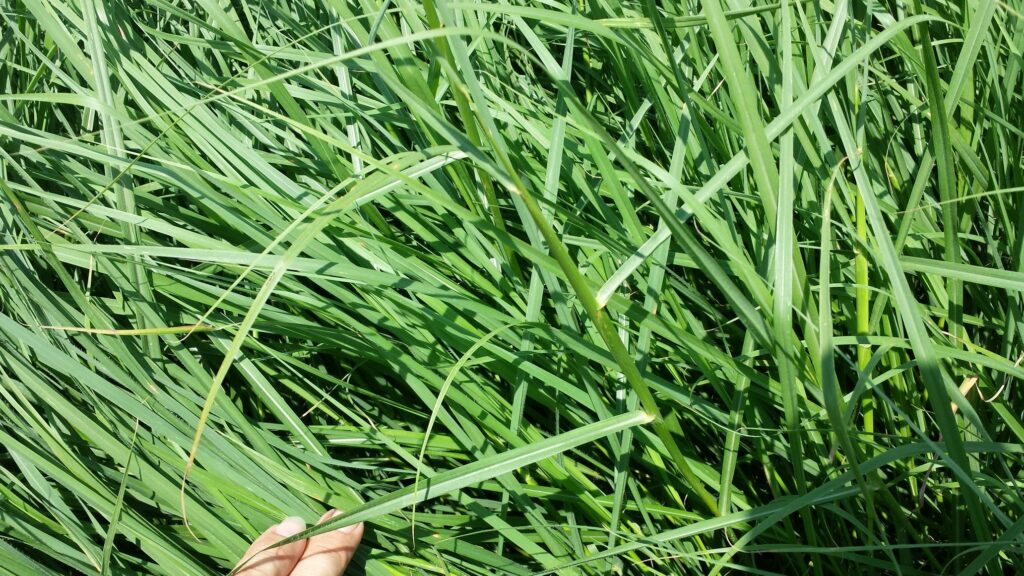
Range of Adaptation
The general area of adaptation is same for “Plains” and “WW Spar” varieties, from Oklahoma and Texas panhandle to south Texas. WW B. Dahl is best adapted to areas receiving from 15 to 35 inches of average rainfall. Soil PH range 5.5 – 8.0, best production PH will occur nearer 7.
Stand Establishment

Old World bluestems are best adapted to well-drained sites of loam, clay-loam, clay, and sandy-loam soils. Stand establishment on sandy soil is riskier, but usually can be obtained. Seeding should be on a firm seedbed, planting at shallow depths (1/4” or less). Seeding rates of 3 to 5 pure live seed (pls) pounds per acre of Old World Bluestems (OWB) plus 1 pls pound of Green Sprangletop are generally recommended. The best results have been obtained when seeding was done with a drill specifically designed to handle “fluffy” grass seeds. The seedbed should be very firm, smooth, and weed-free. It is necessary for some regions, such as; western Texas to seed into dead litter residues like wheat stubble remaining from the previous year’s crop to avoid bare ground in an effort to eliminate soil erosion.

Fertilizer Recommendations
For best results, fertilize according to a soil test for the establishment and desired production levels. Local conditions, current growing conditions, and management objectives must be considered. In order to limit the competition of weeds and annual grasses, do not apply fertilizer until seedlings are evident unless the seeded area has a serious fertility problem. Under high rates of fertilization in high rainfall areas or with irrigation, “WW B. Dahl” has been known to produce as much as 16,000 pounds of forage per acre. It is more realistic to expect 4000 to 8000 pounds per acre under moderate fertilization (30 to 90 pounds of N per acre). Like most other introduced grasses, it will produce fairly well without fertilizer for about two years. After that, production drops off sharply unless additional soil nutrients are applied. Old World bluestems respond very favorably to nitrogen fertilization. Studies show that 20 to 50 pounds of additional forage will be produced for each pound of actual nitrogen added. A single application of 60 pounds of N/acre in April is as effective or in some years more effective than split applications. Higher rates of nitrogen are appropriate in eastern Oklahoma and on irrigated sites. In addition to improving forage yields, nitrogen fertilization will also improve the crude protein content of the forage.
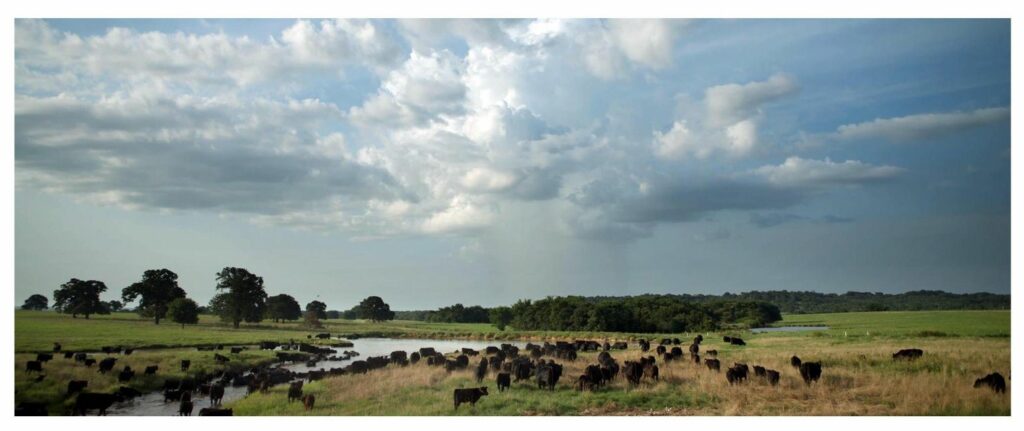
Grazing Season
Old World bluestems typically begin growth in mid-April. As with other warm-season grasses, most of the forage production from Old World bluestems occurs by mid-July. However, these introduced bluestems are more responsive to late-summer and fall precipitation than are the native grasses. As such, substantial regrowth can occur in August and September when moisture is available. In general, Caucasian and WW-Spar
attain peak production earlier in the summer than does Plains. Plains is a mixture of 30 different varieties each maturing at slightly different times, thus a longer green grazing season is present than in the other cultivars.
Forage Quality and Palatability
Several factors influence forage quality, including the stage of growth, species of grass, and soil fertility. All warm-season grasses, including Old World bluestems, are highest in forage quality (crude protein and digestibility) in early summer (May-June) when new plant growth is most available. After mid-July, forage quality declines rapidly until the fall, after which time forage quality remains rather constant. By manipulating stage of growth, either by grazing or haying, forage quality at levels suitable for beef production can be maintained throughout most of the summer.
Old World bluestems offer higher quality forage during late-summer (July to August) than grasses like Bermudagrass, Weeping Lovegrass, or tallgrass native range (Big Bluestem, Switchgrass, Indiangrass, and
Little Bluestem).
Old World bluestem is similar in quality during late summer to the short and mid-grass native range, (Buffalograss, Blue Grama, and Sideoats Grama).
Limited grazing trials with stocker cattle at Haskell suggests that gains from July through August were higher on Plains than ‘Midland’ bermudagrass at similar fertility levels. Studies at woodward indicate that steer gains from Old World bluestems were higher in late-summer than from either native range of weeping lovegrass. Studies at the Marvin Klemme Research Range near Cordell indicate short and mid-grass native range equals or exceeds “Old World” bluestem forage quality from September through the fall. The native range was preferred for wintering cattle.
Generally, forage from “OldWorld” bluestems meets or exceeds recommended requirements for animal growth from May to July 15, but additional protein supplementation may be necessary during other
periods, especially with stocker animals.
All of the commercially available Old World bluestems are similar in forage quality. Digestibilities typically range from 50 percent to 65 percent and crude protein content varies from 4 percent to 13 percent, depending primarily on the stage of growth of the grass. Studies have shown that Caucasian maybe slightly less digestible (1 to 3 percentage points lower) than Plains or WW-Spar, however, the additional forage yields obtained from Caucasian probably offset such minor difference in forage quality. (Oklahoma Cooperative ExtensionService ANSI-3020)
Beef Production
Stocker gains on Old World bluestems range from 1 to 2 pounds/day during summer and from 0.1 to 0.5 pounds/ day during winter. Stocker gains can exceed 2 pounds/day from early-May to mid-July when forage quality is highest, but gains tend to drop off during late-summer unless additional protein supplementation is available. Also, during winter; stocker gains on dormant grass will require protein supplementation. Because cows have lower protein requirements than stockers, OldWorld bluestems can provide most of the necessary nutrients for a longer period of time for cows than for stockers. However, additional protein will still be necessary during winter and possibly other times, depending on the physiological condition of the cow (i.e., lactating, late-pregnancy, etc.)
Cattle gains from Old World Bluestem on old cropland sites are often higher than gains from upland native range sites because of differences in soils and the addition of purchased fertilizer. Stocking rates on Old World will vary from 1 steer per 3 acres for the growing season in western Oklahoma to about 1 steer per acre in central and eastern Oklahoma. At these stocking rates, beef production can reach 200 pounds per acre on cropland sites with good fertility and moisture. Stocking rates should be based on forage availability. Stocking rates will vary from year to year depending on rainfall. Stocking rates can be increased by 10 percent to 25 percent by using rotational grazing as opposed to continuous, season-long grazing.
Hay Production & Value

Limited studies have been conducted on the value of Old World bluestem hay. These studies indicated that when properly fertilized and harvested at the appropriate stage of growth, high yields of good quality hay (10 percent to 16 percent crude protein) can be obtained. Caucasian, WW-Spar and Plains bluestem stands have produced as much as 3 to 4 tons of hay/ acre with an in-vitro dry matter digestibility of 57, 61, and 60 percent, respectively. Steers fed good quality Caucasian bluestem hay, supplemented with adequate protein, gained over 2.2 Lbs./day during winter feeding trials. WW-Spar bluestem hay, baled after full seed head stage, produced gains of 1.44 Lbs./head/day in the same study.
(Oklahoma Cooperative Extension Service ANSI-3020)
Grazing Management
The amount of beef that can be produced from a pasture depends upon (a) the amount and quality of forage produced and (b) how efficiently the animals harvest the forage. As discussed previously, Old World bluestems can produce large amounts of forage when moisture and fertility requirements are met. Proper grazing management is necessary, however, to maximize the conversion of grass to beef. Grazing management incorporates such items as stocking rates, the season of grazing, grazing distribution, and proper grazing system.
Continuous grazing offers good animal performance but tends to promote uneven (spot) grazing. Rotational grazing promotes better grazing distribution and forage utilization. Also, by providing alternating periods of grazing and rest, rotational grazing increases plant vigor and subsequently higher forage production. As a result, beef gains per acre can be increased 10 to 25% by using some form of rotational grazing plan.
Rotational grazing involves subdividing a large pasture into smaller pastures, called paddocks. This is done most economically with electric fencing. The number of paddocks will vary, but most systems use three to six paddocks. Livestock is rotated throughout the paddocks as forage conditions dictate. Generally, when forage growth is rapid, movement is rapid (every five to ten days), whereas when forage growth is slow, as, during a drought, the speed of rotation is slower (every three to five weeks). This type of grazing maintains the grass at a higher growth rate and better forage quality than if grazed continuously. Grazing should begin when grass reaches 12 to 18 inches in height and continue until the grass is grazed down to a 3- to 4-inch stubble height.
Livestock is then rotated into the next pasture, and so on. The system should be designed so that animals will return to the first paddock in four to six weeks. Flexibility is critical in a rotational system. Livestock moves should be based on forage availability and maturity, not by a set number of days. After 6 to 8 weeks of growth, forage becomes mature and loses quality rapidly. If forage growth is too fast to keep pace with grazing, then that paddock should be harvested for hay.
(Oklahoma Cooperative Extension Service ANSI-3020)
Forage Systems
Forage systems incorporate forages that complement each other to allow for maximum beef production from an area. Different forages are selected based on their growing season, production characteristics, and seasonal forage quality. Old World bluestems have good potential as a component of
forage systems for the southern Great Plains. In western Oklahoma, forage systems may utilize such forages as native range, weeping lovegrass, forage sorghums, alfalfa, bermudagrass, small grain pastures, and Chisholm Summer Dormant, endophyte-free, Tall Fescue (www.chisholmfescue.com) in addition to Old World bluestems. For eastern Oklahoma, these forages plus others like annual and perennial clovers and tall fescue should be considered.
